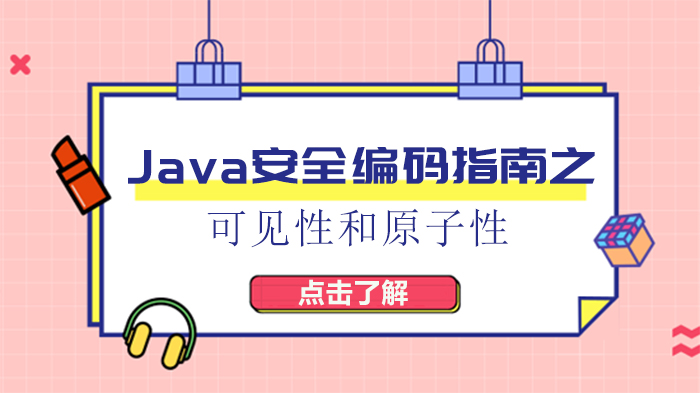
在Java多线程开发中,不可变对象常被视为线程安全的"护身符",但实际应用中其可见性问题往往被忽视。所谓不可变对象,指初始化后状态完全固定的对象——类声明为final且所有字段为final,例如:
public final class ImmutableData {
private final int value;
public ImmutableData(int value) {
this.value = value;
}
}
但需注意:对象本身不可变不代表对其引用的可见性有保障。假设存在一个管理类:
public class DataManager {
private ImmutableData dataRef;
public ImmutableData getData() { return dataRef; }
public void setData(int newValue) { dataRef = new ImmutableData(newValue); }
}
在多线程环境下,一个线程调用setData更新引用后,其他线程可能无法立即看到新值。这源于JVM的指令重排序优化与CPU缓存机制——写操作结果可能暂存于本地缓存,未及时同步到主内存;读操作可能直接从缓存读取旧值。
解决可见性问题的核心是建立"先行发生"(happens-before)关系。常用方案包括:
public class VolatileDataManager {
private volatile ImmutableData dataRef;
public ImmutableData getData() { return dataRef; }
public void setData(int newValue) { dataRef = new ImmutableData(newValue); }
}
多线程环境中,对共享变量的复合操作(如i++、i *= 2等)常因非原子性导致数据不一致。以简单的计数器为例:
public class SimpleCounter {
private int count = 0;
public int increment() { return ++count; }
}
看似简单的++操作实际包含三个步骤:读取内存值→寄存器递增→写回内存。多线程并发执行时,可能出现两个线程同时读取旧值,递增后写回相同结果的情况(如初始值为0,两个线程操作后结果可能为1而非2)。
针对此类问题,可采用以下解决方案:
通过synchronized关键字修饰方法,确保同一时刻仅一个线程执行操作:
public synchronized int safeIncrement() { return ++count; }
使用ReentrantLock实现更细粒度的锁控制:
public class LockCounter {
private int count = 0;
private final ReentrantLock lock = new ReentrantLock();
public int lockIncrement() {
lock.lock();
try { return ++count; }
finally { lock.unlock(); }
}
}
利用AtomicInteger等原子类,通过CAS操作原子性:
public class AtomicCounter {
private AtomicInteger count = new AtomicInteger(0);
public int atomicIncrement() { return count.incrementAndGet(); }
}
单个原子类操作虽能原子性,但多个原子类协同操作时仍可能出现不一致。例如,需要同时更新两个关联的原子变量:
public class PairUpdater {
private AtomicInteger a = new AtomicInteger(0);
private AtomicInteger b = new AtomicInteger(0);
public void updateBoth(int newA, int newB) {
a.set(newA);
b.set(newB);
}
public int getSum() { return a.get() + b.get(); }
}
若线程1执行updateBoth(10,20),线程2同时执行updateBoth(30,40),getSum()可能返回10+40或30+20等非预期组合。这是因为两个set操作之间缺乏同步机制。
解决此类问题需将多个原子操作纳入同一同步范围:
例如,重构为不可变Pair对象并通过AtomicReference管理:
public class AtomicPair {
private static class Pair {
final int a;
final int b;
Pair(int a, int b) { this.a = a; this.b = b; }
}
private AtomicReference<Pair> pairRef = new AtomicReference<>(new Pair(0, 0));
public void safeUpdate(int newA, int newB) {
pairRef.set(new Pair(newA, newB));
}
public int getSafeSum() {
Pair current = pairRef.get();
return current.a + current.b;
}
}
链式调用(如builder模式)在多线程环境中可能因中间状态可见性导致数据混乱。例如,直接对共享对象进行链式设置:
public class UserInfo {
private String name;
private int age;
public UserInfo setName(String name) { this.name = name; return this; }
public UserInfo setAge(int age) { this.age = age; return this; }
}
多线程并发调用setName().setAge()时,可能出现线程A设置name后,线程B覆盖name再设置age,导致最终对象状态不一致。
推荐使用线程安全的构建模式:先在本地线程内完成对象构建,再将完整对象赋值给共享引用。例如:
public class ThreadSafeBuilder {
public static class Builder {
private String name;
private int age;
public Builder setName(String name) { this.name = name; return this; }
public Builder setAge(int age) { this.age = age; return this; }
public UserInfo build() { return new UserInfo(this); }
}
private volatile UserInfo sharedUser;
public void updateUser(String name, int age) {
UserInfo newUser = Builder.newInstance().setName(name).setAge(age).build();
sharedUser = newUser;
}
}
Java中long和double类型的读写操作在32位JVM上可能被拆分为两个32位操作,导致多线程环境下出现"半更新"现象。例如:
public class LongHolder {
private long value;
public void setValue(long value) { this.value = value; }
public long getValue() { return value; }
}
线程A写入0x123456789ABCDEF0,线程B可能读取到0x12345678FFFFFFFF(前32位新值+后32位旧值)。解决方法是将变量声明为volatile,强制64位原子操作:
private volatile long value;
可见性与原子性是Java并发编程的核心课题,需根据具体场景选择合适方案:
掌握这些技术要点,能有效规避多线程环境下的数据不一致问题,构建更健壮的Java并发应用。